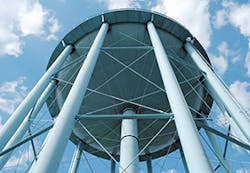Whether cost or a myriad of other reasons make connecting an individual site’s water supply to a municipal water supply unfeasible, many applications require storage of a large volume of water. In many of these applications, whether they are for potable or non-potable water, facility owners must meet a water purity standard. Obviously, water treatment systems are an important factor in purifying water, but the containment vessel itself should not be overlooked.
POTABLE WATER SYSTEM STANDARDS
Most governmental agencies that regulate drinking water supplies require manufacturers, sellers, and distributors of water treatment or distribution products in North America to ensure that their products comply with NSF/ANSI 61: Drinking Water System Components–Health Effects. This standard was developed by a team of scientists, industry experts, and key industry stakeholders, and it sets health effects criteria for many water system components. These components include protective barrier materials, e.g., cements, paints, and coatings; joining and sealing materials such as gaskets, adhesives, and lubricants; and non-metallic potable water materials.
Views of the inside of a corroded hot water storage tank and a resurfaced, coated and painted surface
Tom Tietjen, vice president of sales and marketing at Xerxes, a leading provider of fiberglass tanks for liquid storage, notes the importance of storing water in a vessel that complies with NSF 61 for potable applications. The project owner cannot expect to store drinking water in a substandard vessel and then somehow expect to filter it for human consumption, Tietjen says. He adds that other system components, such as faucets and pumps, must be NSF 61-compliant as well. Additionally, even if the tank lining material is NSF 61-compliant, Tietjen points out, the owner must ensure that corrosion does not cause enough contaminants to get into the water to exceed specified contaminant levels. Tietjen indicates that, even if a filtration system purifies the water to a potable level in this scenario, the vessel’s structural integrity may be compromised at some point.
NSF 61 may apply to the sum of a vessel’s parts, Tietjen points out. For example, an engineer may select a steel tank and specify that it be coated with an NSF 61-compliant resin. Essentially, such a composite tank qualifies as NSF 61-compliant, Tietjen says. Xerxes manufactures NSF 61-compliant tanks for potable water applications. Like any provider of NSF 61-compliant coating resins, Xerxes’ manufacturing facilities are subject to random NSF International inspections of its processes, and its tanks must comply with NSF 61 test standards.
AmTech Tank Lining provides tank lining and tank repair products and repair services for many potable water applications, in addition to petroleum and chemical containment applications. The most common types of potable water customers are municipalities, counties, and the federal government, e.g., national parks, reports Rob Pearlman, senior containment systems engineer and managing director. A sister company, American Fiberglass Tank Repair, fixes leaks in fiberglass tanks and complements AmTech’s work on steel tanks.
POTABLE WATER TREATMENT
The vessel is just one component and, arguably, not the most important one in a potable water storage and distribution system when it comes to facilitating the required level of water purity. The World Health Organization provides an overview of water treatment disinfectants and coagulants.
The three chemicals most commonly used as primary disinfectants are chlorine, chlorine dioxide, and ozone. Monochloramine, also known as chloramine, is used as a residual disinfectant for distribution. Chlorine is the most widely used primary disinfectant and is also often used to provide residual disinfection in the distribution system. Chlorine dioxide breaks down to leave the inorganic chemicals chlorite and chlorate, levels of which are managed via control of the dose of chlorine dioxide applied to the water. Ozone is used as a primary disinfectant but cannot be monitored in drinking water because it leaves no residual. Monochloramine, used as a residual disinfectant for distribution, is usually formed from the reaction of chlorine with ammonia.
Coagulation and flocculation are also used in the process of treating water. These processes reduce naturally occurring organic matter and turbidity, which can degrade disinfection efficiency. Chemicals employed as coagulants in drinking water treatment include aluminum and iron salts, such as aluminum sulfate, polyaluminum chloride, or ferric sulfate. Sometimes organic polymers, known as coagulant aids, are incorporated to assist with coagulation. Treatment systems must ensure that coagulation does not leave excessive amounts of aluminum and iron in the water. Sodium hydroxide is sometimes utilized for adjusting pH, and, in some cases, chemicals for fluoridation are also used. Ion-exchange resins and more advanced treatment processes that use membranes are increasingly used in drinking water treatment as well.
Two 35,000-gallon fiberglass underground storage tanks installed at a data center in Pennsylvania
NON-POTABLE APPLICATIONS AND WATER QUALITY
Potable applications are not the only ones in which water quality is a high priority, Pearlman says. Even some wastewater applications require the removal of certain types of contaminants that could damage treatment systems. AmTech also repairs concrete holding tanks at wastewater treatment plants for municipalities and counties. These tanks often cannot be taken out of service, requiring concrete spalling to take place inside the tank. Workers must adhere to confined-space protocols and be assured of adequate ventilation before they enter the tank and chip out the spalled concrete. AmTech repairs the concrete using pressure injection of different types of cement grouting and poly materials.
“A coating is only as good as the substrate underneath it,” points out Pearlman. “A good portion of the work we do is restoration and preparation of the substrate, whether it is concrete, fiberglass, steel, or some other specialized material. Restoring it is just as important as applying the lining.”
Tietjen notes that water quality is not generally a high priority in many applications for which Xerxes builds tanks, such as fire protection, rainwater harvesting, chiller unit condensation collection, greywater recycling, and stormwater retention. Most systems include filtering.
Often, different standards apply to tanks used for these non-potable applications. For example, Xerxes’ fiberglass underground tanks used for fire protection systems are designed to adhere to the National Fire Protection Association’s NFPA 22, Water Storage Tanks for Fire Protection Systems and NFPA 1142, and Water Supplies for Suburban and Rural Fire Fighting standards. NFPA 22 has requirements covering the design, construction, installation, and maintenance of tanks and accessory equipment that supply water for private fire protection, including tanks and pipe connections and fittings. NFPA 1142 identifies a method of determining the minimum requirements for alternative water supplies for structural firefighting purposes in areas where the authority having jurisdiction determines that adequate and reliable water supply systems for firefighting purposes do not otherwise exist.
For wastewater applications, Xerxes manufactures one-piece wastewater storage tanks in capacities up to 60,000 gallons for aboveground or underground deployment. The company gives the option to field pressure-test the units before and after installation. One of the reasons why an owner might opt for fiberglass is speed of installation compared with the time involved in constructing a concrete tank, for example.
NATIONAL PARKS A GOOD FIT
National parks have proven to be a good fit for Xerxes’ fiberglass tanks. According to the company, the fact that its tanks have been used extensively by the oil industry for many years influenced the Forest Service’s decision to use them. In the first half of the past decade, the United States Department of Agriculture Forest Service began installing and putting into service these tanks in national forests throughout the western United States. These forest installations turned out to be a good fit for tanks that are designed for durability and long life, as well as lightweight and easy installation. The cost was deemed to be competitive as well.
Boise National Forest in Idaho was the first forest in its region to use the company’s water tanks; soon, five sites would be equipped with one of the company’s fiberglass potable water tanks to store drinking water. The first installation in Boise National Forest was in September 2003, a 20,000-gallon potable water tank at the Garden Valley Ranger Station. Since then, tanks ranging in capacity from 2,000 gallons to 10,000 gallons have been installed at four other sites in Boise National Forest: Barber Flats Guard Station, Crawford Guard Station, High Valley Work Center, and Lester Creek Guard Station.
The installation process in remote sites, such as those at national forest stations, does not involve a great deal of equipment. Typically, the tank is delivered to the site by a truck or low-boy trailer and the tank is offloaded onto the station parking lot, which invariably is large enough. Sometimes the installation contractor offloads the tank to a trailer to get the tank up a hill and then uses a small crane or excavator to place the tank in the hole—if there’s an access road up to the site.
In cases in which there is no access road, the contractor usually has to push the tank uphill with an excavator or a loader. Because the fiberglass tank is much lighter than a steel tank, the transport and installation processes are easier.
Idaho is an example of a state that has stringent requirements for storing potable water. The state has adopted as its standard the Recommended Standards for Water Works: Ten State Standards, which has been adopted by Illinois, Indiana,
Iowa, Michigan, Minnesota, Missouri, New York, Ohio, Pennsylvania, and Wisconsin, and the Canadian province of Ontario. The standards require a lockable hinged lid, a feature that Xerxes had already developed, that allows easy access for operation and maintenance for the installation in Colorado’s San Juan National Forest.
The state of Idaho also requires the riser on the potable water tank to have a 2-inch lip and a gasket on top. The manufacturer adhered to these requirements by providing the Forest Service with an NSF-listed underground fiberglass tank with a riser that has a hinged, lockable lid. Both the riser and lid have a gel-coated tan color designed to blend into the forest environment.
A 10-foot, 8,000-gallon vertical storage tank
MARINA PROJECT SUITS REC SEASON AND WINTER USE
A more recent project that reveals the suitability of a fiberglass tank to underground water storage is the installation of 25,000- and 300-gallon Xerxes tanks at Goose Bay Marina on the eastern shore of the Canyon Ferry Reservoir near Helena, MT, for the US Department of Interior Bureau of Reclamation’s Montana Area Office. The bureau favored this type of tank from early in the planning stages because it had experience with similar tanks, and because it wanted to avoid the potential for vandalism, according to Jeff Nelson, P.E., of Denver-based Wright Water Engineers. A Xerxes tank was specified for the project because the entire tank had NSF 61 certification, Nelson adds.
The marina’s campsite concession area was being modernized with a store, RV campsites, a potable water fill station, shower and restroom facilities, and day use areas. The project, which began in fall 2014, included creating a public water system to serve the site guests, which included storage tanks for summer use and winter use, plus a pressurized water distribution system with booster pumps and chlorine disinfection. The water storage is used for chlorine contact time, distribution system equalization storage, and to meet the maximum daily demand during the recreation season.
A new groundwater well, which was not fed by surface water, was drilled for the project. The groundwater is pumped to a water treatment building for sodium hypochlorite injection and then pumped to one of two tanks. The 25,000-gallon tank will service the facility during the April 15–to–October 15 operating season. The 300-gallon tank will be used outside of the operational season when the concession store remains open. The storage system was installed in an open excavation and then buried on a hillside above the water treatment building, which contains a booster pump skid.
The water distribution system has two main components: a “shallow bury” summer-use-only system and a “deep bury” full-year-use system. Both systems are pressurized by the single booster pump skid, which receives water from either tank. The shallow bury water distribution system provides service to the full-service RV campsites. The deep bury water distribution system provides service to the concession store and a few isolated campsites. Before the winter, the shallow bury water distribution system is drained and blown out for freeze protection. The water system is fully automated, with a water level probe in the tank with settings to operate the booster pump station and disinfection system.
The project presented a unique challenge for design due to the wide range of water demands calculated, the peak-season, maximum day demand 100 times greater than the off-season maximum demand, and the need to balance the high demands with winter time water age. The system is still under construction, but all parties involved anticipate that it will perform well and enhance the recreation opportunities near Helena starting in spring/summer 2016.
LINING FOR POTABLE APPLICATIONS ADJUSTS TO CHANGES
AmTech developed its NSF 61/ANSI-compliant DuraChem 580 PW Polylining system to line steel and concrete water tanks that store potable water. According to the manufacturer, this application is unique because linings need to have both high bonding strength and durability. The DuraChem 580 product reportedly provides up to 500 psi adhesion strength and allows for quick repairs with minimal downtime. The lining, which does not contain volatile organic compounds, is applied in a high-temperature, high-pressure, spray-up process. AmTech reports that the lining cures up to its maximum strength in minutes.
According to AmTech, the product was formulated to adapt well to steel and concrete tanks with much greater flex and elongation characteristics than older coating technologies. This is critical, the manufacturer points out, because changes in air temperature, sun heating, and wind deflection can cause expansion and contraction of a tank’s structure and even cause tank movement. The lining was designed to flex, bend, and stretch to accommodate dynamic changes without disbonding from the tank wall substrate. Older, thin mil coatings like epoxy are prone to failures due to physical changes.
LININGS FOR NON-POTABLE APPLICATIONS
Non-potable hot water and cold water storage can present different challenges due to the temperature of the stored water itself.
AmTech developed its HydraStone cement lining for use on steel hot water tanks after the tanks’ original cementitious or thin mil epoxy linings have failed. The manufacturer points out that if the owner fails to reline the tank, further erosion will occur that will eventually permeate the outer steel wall, ultimately resulting in tank failure. Pearlman recalls several instances similar to that involving the laundry operation at a large hotel convention center in the New York City area that experienced firsthand the result of compromised tank integrity. A facilities manager who was responsible for physical plant operations had received a call from the housekeeping manager, who reported that newly laundered sheets and pillowcases were tinged orange.
“The temperature in a pressurized tank may get up to 600 degrees and traditional linings aren’t going to be able to take that type of elevated heat, so a cementitious coating system is ideal for that,” says Pearlman. “For an OEM cementitious coating product for new tanks, some ask, ‘Why can’t I just go to Home Depot, buy some Quikrete, and put it on there—won’t it do the same thing?’ The main difference is the coefficient of expansion—how heat affects the expansion and contraction of something. If you’re putting a cementitious coating on a steel tank and you’re heating up that tank to hundreds of degrees, the tank is going to expand and contract at a different coefficient of expansion from that of the cement product.” AmTech’s cement lining is designed to mimic the coefficient of expansion of the metal tank, he adds.
Linings have also been engineered to suit steel cold water tanks, according to AmTech. Many buildings need large volumes of water for air-conditioning system chillers. The sheer volume of water can stress these tanks, so they require periodic inspections to ensure that their structural integrity is holding up. When the existing internal coatings reveal signs of ultimate failure, these tanks can be efficiently relined and quickly returned to service using AmTech’s DuraChem 580 polylining system, or a HydraStone Alkrete cement lining. According to themanufacturer, these linings suit cold-water storage tanks from 1,000- to 2-million-gallon capacity and above.
Pearlman describes the DuraChem lining, which is applied at high temperature and high pressure and sets up immediately, serving as “Tupperware for a tank,” a flexible material that doesn’t break down or deteriorate. Some thin-mil tank coatings reveal corrosion issues not unlike blistering on the paint on a car’s rocker panels, Pearlman adds. Oxidation causes a bubble to form, and the condition spreads until the coating is rendered ineffective and the condition threatens the tank’s structural integrity. The AmTech lining does not allow blistering to spread beyond its membrane because the curing process establishes a monolithic integrity of the lining’s membrane.
The HydraStone lining works differently, Pearlman explains. In contrast to the DuraChem lining, which forms a waterproof membrane, HydraStone hydrates. However, sacrificial anodes installed on the tank surface prevent the hydration from promoting corrosion.





